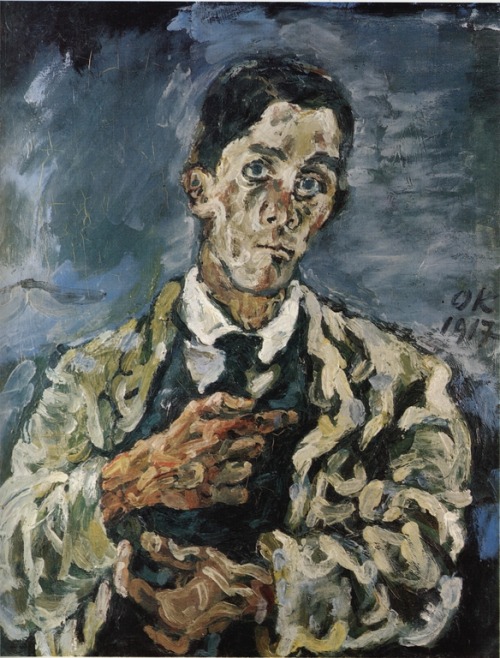The exhibition entitled ‘Oskar Kokoschka - Portraits of People and Animals’ at the Museum Boijmans Van Beuningen, Rotterdam, 21 September 2013 - 19 January 2014 will take the visitor on a tour through the exceptional oeuvre and tempestuous life of the Austrian painter.
Gustav Klimt called him ‘the greatest talent of the younger generation’. This major retrospective brings together Kokoschka’s confrontational portraits more than half a century after his work was last exhibited in the Netherlands.
Visitors entering the large Bodon galleries in Museum Boijmans Van Beuningen will go back a century in time. Large advertising columns take the spectator back to the European city as it was at the start of the 20th century. The columns will introduce the eight themes of the exhibition, including the animal portraits and the political allegories. From Vienna, to Berlin, to Dresden: the confrontational portraits will introduce the visitor to the circle of famous writers, architects and politicians in which Kokoschka moved.
Vienna
In 1904, Kokoschka was admitted to the Kunstgewerbeschule in the Vienna of Sigmund Freud, Gustav Klimt and Hans Makart. Here, the painter rebelled against the established order. He painted models in movement, even though the decorative Jugenstil was the norm. Kokoschka exhibited his work at the Vienna Kunstschau exhibition, organized by Gustav Klimt. At the Kunstschau architect Adolf Loos discovered Kokoschka.
Kokoschka’s success was largely due to the modernist architect Loos. His circle of friends in Vienna’s intellectual and cultural elite became Kokoschka’s biggest clients. This resulted in his early portraits of people such as

publicist Karl Kraus

and publisher of the avant-garde magazine Herwarth Walden,
both of which can be seen in the exhibition.
He also obtained access to the soirées of the philanthropic Eugenie and Hermann Schwarzwald. Through Loos he became acquainted with the composers Arnold Schönberg, Anton Webern and Egon Wellesz. As up and coming artist in Vienna, Kokoschka came into contact with the work of Anton Romako and George Minne, but Edvard Munch, Vincent van Gogh and the objects from the Völkerkundemuseum also became important sources of inspiration for him.
At the age of twenty-six Kokoschka met the love of his life: Alma Mahler, the widow of the composer Gustav Mahler. She was a great source of inspiration during their three-year relationship. In addition to writing 400 love letters, he painted a portrait of Alma in the style of the Mona Lisa, three double portraits - one of which is included in the exhibition - and numerous prints and drawings. Soon after their relationship ended, Alma married the architect and founder of the Bauhaus, Walter Gropius. It took Kokoschka a long time to recover from the break-up; he even had a doll made in Alma’s likeness.
Kokoschka exhibited his work together with the art movement Der Blaue Reiter, to which Wassily Kandinsky and Franz Marc belonged.
In 1937, Kokoschka fled to England after the Nazis had confiscated four hundred of his works. Kokoschka ventilated his political position in paintings in which Hitler, Mussolini and the prime minister of the United Kingdom Arthur Neville Chamberlain play the leading role.
Kokoschka began to explore an individual path even during his studies at the Kunstgewerbeschule in Vienna. In the period dominated by Art Nouveau with an emphasis on ornament, he focussed on people. Kokoschka’s portraits show us how he viewed mankind and the world. In a television interview in 1966, Kokoschka said that he was interested in a ‘person’s aura in space’. He thought it was important to express the sitter’s psyche. He often made his models look older, as if he could see into the future. The result was that many clients did not buy their unflattering portraits. Kokoschka’s works are characterised by bold colours and dynamic brushwork. This is typical of Expressionism, a movement typified by exaggerated forms, bright colours and distorted reality.
In addition to numerous portraits of people, the exhibition also features more than twenty paintings of animals. Kokoschka was fascinated by animals, in which he often detected human characteristics. He painted the ‘Mandrill’ in London Zoo, outside public opening times. In the evening he was admitted to the zoo by zoologist Julian Huxley, brother of Aldous Huxley, the author of ‘Brave New World’. Rather than depict the monkey in his small cage with thick bars, Kokoschka shows it in its natural environment.

The exhibition is accompanied by a richly illustrated catalogue with essays by Beatrice von Bormann, Katharina Erling and Régine Bonnefoit. ISBN: 978-90-6918-267-4
_2.jpg&cache=yes)
Oskar Kokoschka, Mandrill, 1926, oil on canvas, 127 x 102 cm, Collection Museum Boijmans Van Beuningen. © Fondation Oskar Kokoschka, Vevey / 2013, ProLitteris.

Oskar Kokoschka, Double portrait of Hans Mardersteig and Carl Georg Heise, 1919, Collection Museum Boijmans Van Beuningen. © Fondation Oskar Kokoschka, Vevey / 2013, ProLitteris.

Oskar Kokoschka, Self-Portrait 1917, 1917, Oil on canvas, 79 x 63 cm, Collection Von der Heydt-Museum Wuppertal. © Fondation Oskar Kokoschka, Vevey / 2013, ProLitteris.

Oskar Kokoschka, Double Portrait Oskar Kokoschka and Alma Mahler, 1912-13, oil on canvas, 100 x 90 cm, Collection Museum Folkwang, Essen. © Fondation Oskar Kokoschka, Vevey / 2013, ProLitteris.

Oskar Kokoschka, The Power of Music, 1920. Coll. Vanabbemuseum, Eindhoven. Photo: Peter Cox.© Fondation Oskar Kokoschka, Vevey / 2013, ProLitteris.

Oskar Kokoschka, Auguste Forel, 1910, oil on cnavas, 70 x 58 cm. Collection Kunsthalle Mannheim. Photo: © Kunsthalle Mannheim, Cem Yücetas. © Fondation Oskar Kokoschka, Vevey / 2013, ProLitteris.

Oskar Kokoschka, Felix Albrecht Harta, 1909, Collection Hirshhorn Museum and Sculpture Garden, Smithsonian Institution, Washington, D.C., (...). © Fondation Oskar Kokoschka, Vevey / 2013, ProLitteris.

Oskar Kokoschka, Time, Gentlemen Please, 1971-71, oil on canvas, 130 x 100 cm. Collection Tate, Londen, purchase 1986. . © Fondation Oskar Kokoschka, Vevey / 2013, ProLitteris.

Oskar Kokoschka, Adolf Loos, 1909, 74 x 91 cm, Stiftung Preussischer Kulturbesitz, Staatliche Museen zu Berlin, Neue Nationalgalerie. © Fondation Oskar Kokoschka, Vevey / 2013, ProLitteris.

Oskar Kokoschka, Pietà (playbill for the Kunstschau Vienna), 1908, publ. 1909, Collection Museum der Moderne Salzburg. © Fondation Oskar Kokoschka, Vevey / 2013, ProLitteris.